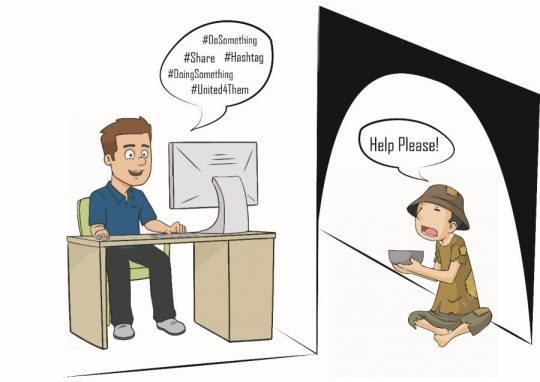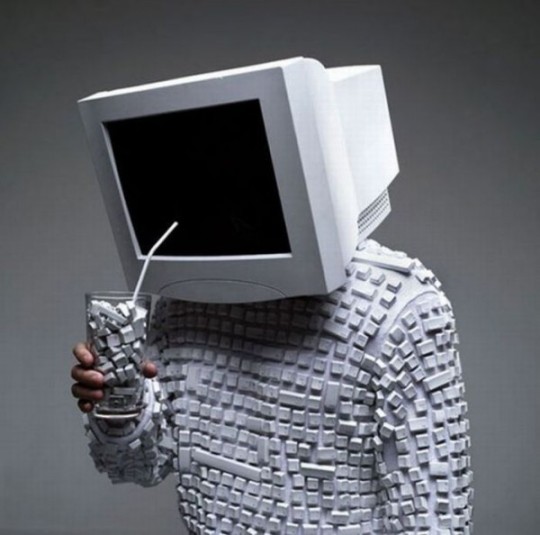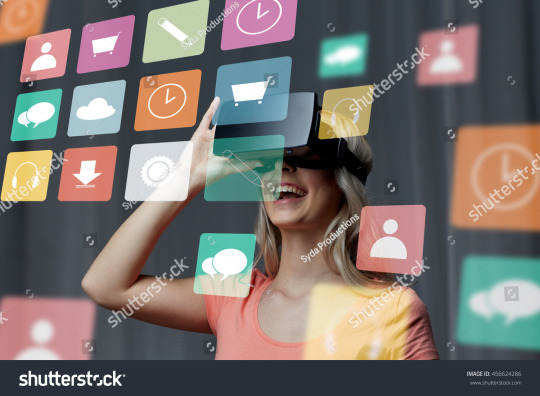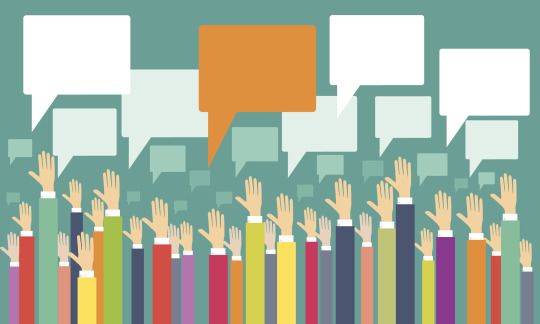In the digital era, a Second Self emerged from cyberspace and affecting people daily life. The following fove posts will analyse this phenomenon in terms of reality, social media, high tech product, social movement and democracy.
Don't wanna be here? Send us removal request.
Text
Social movement and Slacktivism

Social movement as defined as groups or communities, based on similar identities, aims to achieve their political and cultural ambition with information interactions (Wim et al. 2004, p77). There are two primary forms of action, collective and connective action that are actively used in social movement. What distinguishes collective and connective action is the way they employ social and digital media. Collective action uses media technology to engage and organise their members for raising the protest, whilst connective action creates and develops the influence entirely relay on the digital platform (Bennett & Segerberg 2012). Although there are many significant examples of connective action such as the Ice Bucket Challenge and the Arab Spring, it is difficult to find out how many participants are truly cared and active in the protest.
Thus, here comes to Slacktivism that people are actively online and participant in digital protest which authentically gain little efforts in the current power structure (Humphreys 2016, p246). Connective action seems powerful and grows rapid because it can raise public attention within hours and gain millions of audiences, but influence decreases fast because information is overloading online. Regarding Humphreys that one aspect claims online protest is harmless because it cannot affect anything in real life, which is wrong. Take Tunisia as an example that people used Facebook as their weapon to fall their regime in 28 days (BBC2 England 2011). Social media can unite people, and it is the essential power of raising a social movement.
The negative side of connective action such as Slacktivism can be resulted by two different selves as discussed above. People are looking for fun, liberal and enjoyment in the digital world to relieve their stress in reality. The democratic meaning of entertainment in media is ignored by the public, who automatically separate politics and entertainment (Curran 2011, p63). Therefore, the second self may be less interested in serious, troublesome and nervous issues such as online protest and political news. Research maintains that people prefer to like a Facebook post rather than donate or active offline (Kristofferson, White & Peloza 2014 cited by Humphreys 2016, p246). For instance, Ice Bucket challenge was famous in 2014 and attracts millions of participants; it can seem like a success because it gains over $106 millions donations. However, most of the participants are taking the challenge as enjoyment without understanding the activity, and some did not obey the rule to either donate or take the challenge (Perez 2014).
It is evident that the power of social media is enormous and can be used to fight against the government such as Tunisia and Egypt. Positively, the internet is immediate and promote with intense emotion, that can quickly gain social attention; this is one of the reasons why Tunisia and Egypt protest a success. Nevertheless, in the digital domain, people are careless, relaxed and less responsible (e.g. Slacktivism), also because information is flowing, so people are unable to focus on one issue. With digital media, the second self is becoming lazy and distrustful, which affects the first self synchronously, and increase the difficulty to engage people in participating activities either on and offline.
0 notes
Text
Is technology determine our way of life?

Since digital technology was invented, the debate about how technology change human life began and continue in the present day. Some argue that it develops out of human control and become a core element in social evolution; this aspect called Technological determinism (Humphreys 2016, p14). The other disagrees and insists that people still have control of technology and consider it as a tool for developing human society; they claim this perspective as Social construction.
Markham (1998, p85) concludes that internet user can be divided into three types regarding their attitude toward digital media. The first group tread it as a tool to facilitate research and other activities in daily life. Some people think it is more like a place for communication, while the rest consider it as a kind of lifestyle that they can express themselves liberally. In my opinion, the only difference between these three groups of people is their level of Internet addiction. There is no doubt that a large number of people are connected in digital dimension, and because cyberspace is more delightful and liberal, less stressful, people get more and more obsessed and start to rely on it.
While people wallow into the digital domain, they are changing technologies and shaped by it synchronously. Media ecology demonstrate an aspect that communication is shaping human society historically and interactionally based on three basic statements: 1)media platform can change message, 2) new media are invented on the basis of old media, 3)social media is the association of different forms of media within social context (Humphreys 2016, p15). Therefore, digital media as the combination of all kinds of traditional media, transform the way of communication and human evolution such as Facebook play a central role in the Arab Spring (BBC2 English 2011). On the other hand, technology is only a tool for the human to achieve their goal and it will not run without human control.
From another perspective, it is also the debate of ‘I’ as a social construction, versus ‘me’ as technology determinism. Goffman’s theory belongs to social construction that claims ‘I’ have control of the whole body and ‘me’, while ‘me’ have a potential influence on ‘I’ because technology can extend human’s senses. The reality where ‘I’ live in, shaped with the development of the environment, the meaning of things, and the extension of sense, under the assistance of digital technology. Moreover, people can gain certain advantages by comparing two self’s behaviour and understand themselves as a whole with two self better. Personally, the digital self is the native personality without limited and affected by reality, or it is the self that people desire as Beth describes cyberspace as a place where people can be the ‘true self’ (Markham 1998, p173).
Overall, the influence is mutual. It is evident that technology plays an essential role in contemporary society and influencing human behaviour while the human is improving technology for better assistance.
0 notes
Text
The creation of the Second Self

The creation of a self can be based on a theory called symbolic interactionism. Regarding Athique (2013, p97), the self is produced from social interaction which creates attribution of the meaning with a thing. In other words, the self arose from the combination of social interactions and association of meanings. Based on this theory, the first self, as ‘I’ in reality, emerged from the material world and the second one, as ‘me’ from the digital domain; they are vario because of different social interaction, environment and association of meaning (p 98). Matthew said cyberspace is shaping the meaning of the thing; he uses the example virtually which used to mean nearly but now can describe a different persona online. In his word, ‘I am a man but virtually a woman’ to illustrate he has a female self in the digital world (Markham 1998, p134).
Moreover, a theory by Erving Goffman (1959 cited by Athique, 2013 p99) maintains that people are a social actor that can act depend on the different ‘stages’, the performances are directed by a ‘backstage’ self carefully. In this theory, ‘I’ as the backstage self is the initial one that controls our physical, psychological body and the second self. Combined with symbolic interactionism, the second self exists only as performance for the particular social interaction. For example, in Markham’s interview with Sheol (1998, p179) shows that Sheol can easily shift between his real and digital self. Even through Sheol calms the two self are entirely separate and independent, it can seem as Sheol is performing based on different roles and identities, in other words, ‘I’ is directing ‘me’. These performances can be understood with a social capital theory that people can gain various kind of benefits from social interaction including self-confident, finance and emotional satisfaction (p105).
Another hypothesis is ‘I’, and ‘me’ are two independent personalities that live in two worlds separately. As mentioned, the self is developed from the social surrounding; the distinction between self-perception and social perception is enormous. Therefore, the first self will be influenced and restricted by social rules, physical limitations and social interactions, while the second self will be developed more liberally under internet protection and fewer limitations compared with reality. However, it is dangerous for an individual to wallow in cyberspace and decrease their participation in real life. As a consequence, the possibility of the user to be depersonalised and form a closed group increased as time spent online. Take Sheol for example, he describes himself as an addict and lets the internet rules his lives. Although he felt unreal when expressing his second self online and confused whether his experience is real. He prefers to live in the digital world and willing to spend as much time as possible in cyberspace (same as Beth and Matthew) (Markham 1998).
It is difficult to define whether they are performing or controlled by their second self. People like Sheol, Beth and Matthew, are wallowing into technology and it is changing their personality potentially.
0 notes
Text
Different self behaviour in reality and cyberspace

Nowadays, digital technology is well-developed and used in many areas. As research has shown, there are over 4.6 billions mobile users around the world in 2018 (eMarketer n.d.). Athique (2013, p110) concludes that personal devices, such as the mobile, laptop, iPod, allow their users to manage their daily life better and high tech product becomes a symbol of modern society. There is no doubt that these devices empower individuals and the whole society. Technology is shaping people lifestyles such as behaviour, identity, and expression. However, the problem is that in the rapidly growing society, a second self is emerged, developed by and living in the online community.
According to Athique (2013, p85), there are three orders of simulation that distinguished by the scale of simulating the material world. Digital media can seem like the third-order simulations which can be created entirely online without resources from reality. Therefore, it is easy for people to create a different self online which is utterly different from the one in real life. Moreover, Athique maintains that there are three layers of reality: 1)physical reality, 2)hyper-reality and, 3)virtual reality. It stands for the material world, social communication world and the fictional world. Based on this, internet users are experiencing the last two world, and it is distinct from physical reality. Thus, behaviour changes depending on the social environment.
In the material world that human communication combines language, body movement, eye contact, gesture, etc. As Dennis and DeFleur study in 2009 (p11) concludes three principles that enable better communication includes accuracy, feedback and role-taking. In the digital domain, information processes mostly through words which decrease the understanding of the receiver because of a lack of three principles. Internet users can easily create and fake information online and shift from different identities at any time under the protection of the screen, which increase the sense of distrustful in the digital world.
For instance, the situation is worst in online dating app and site which are popular and attract millions of users worldwide. Athique (2013, p102) found out that people are presenting a highly particular version of self for online dating to gain self-confident and more attention from the possible matcher. Thus, it is more likely for these users to fake their appearance, job, and other information in online dating app and site. Although other social media platform such as Facebook that also requires a personal profile, it is distinct from online dating because of Facebook user ‘friend’ their relatives, friends in real world and classmate who they truly meet in the face. Thus, the Facebook self is more real than online dating self.
Through the digital domain, the things that people choose to present will be different based on social identity, context, environment, purpose and so on. Under the protection of the screen, the second self can express comfortably without restricted by reality. They can pretend and simulate anything with the assistance of digital technology and release the ‘real’ self without limited by their physical body.
1 note
·
View note
Text
Reference
Athique, A. (2013) Digital media and society: An introduction. Cambridge: Polity Press.
BBC2 England (2011) How Facebook Changed the World: The Arab Spring. Available at: https://learningonscreen.ac.uk/ondemand/index.php/prog/01F3ED1B?bcast=70067018 (Accessed 26 Mar 2019).
Bennett, W. L., & Segerberg, A. (2012). The Logic of Connective Action. The Logic of Connective Action, 15(5), 739-768. doi:10.1080/1369118X.2012.670661
Curran, J. (2011) Media and democracy. Oxon: Routledge.
Dennis, E. E., & DeFleur, M. L. (2009). Understanding media in the digital age. London: Allyn and Bacon.
eMarketer. (n.d.). Number of mobile phone users worldwide from 2015 to 2020 (in billions). In Statista - The Statistics Portal. Retrieved March 26, 2019, from https://www.statista.com/statistics/274774/forecast-of-mobile-phone-users-worldwide/.
Humphreys, A. (2016) Social media: Enduring principles. Oxford: Oxford University Press.
Keane, J. (2013) Democracy and media decadence. Cambridge: Cambridge University Press.
Markham, A. N. (1998) Life Online: Researching real experience in virtual space. Oxford: AltaMira Press.
Perez, S. (2014) ‘The Ice Bucket Challenge, by the numbers’, TechChurch, 3 September. Available at: https://techcrunch.com/2014/09/03/the-ice-bucket-challenge-by-the-numbers/?guccounter=1&guce_referrer_us=aHR0cHM6Ly93d3cuZ29vZ2xlLmNvbS8&guce_referrer_cs=OHOmGyWLLbcTXKfvSGNesQ (Accessed: 28 Mar 2019).
Vaidhyanathan, S. (2018) Antisocial media: How Facebook disconnects us and undermines democracy. Oxford: Oxford University Press.
Wim B. H. J. van de Donk, Loader, B. D., Rucht, D., & Nixon, P. G. (2004). Cyberprotest: New Media, Citizens, and Social Movements. London, England: Psychology Press.
0 notes
Text
Digital media and democracy, present and future

In recent years, many nations are promoting democracy for better governing; it initiates freedom of speech, human right and so on. In the digital era, social media have serious efforts on democracy because of communication abundance, and also bring the society into a ‘low-trust, high-blame’ culture. Take Facebook as a case study; it is one of the most popular and influential social media worldwide, which gains billions of active users. In Vaidhyanathan’s perspective (2018, p5), Facebook has many negative aspects in term of building democracy.
Firstly, information is polluted severely on Facebook cause there is not any restriction of posting. Users are impossible to distinguish fake and truth through social media and decrease their trust in any source online. Secondly, the content on Facebook is promoted with strong emotion. Although democracy needs motivation, it also requires deliberation to be successful, and Facebook is false to contain it. Third, ‘filter bubble’ for companies to understand their users better and reinforces their beliefs (Vaidhyanathan 2018, p6). Under this environment, Facebook users are hardly communicating in a calm, informed and productive way. For this reason, the second self may be more radical and emotional online, with the issue of Slacktivism that people are hardly participant in activities; it affects democracy terribly.
There are many phenomenons such as fake news, propaganda and disinformation; it is a result of information pollution in social media. Moreover, it draws the public attention away from the institutions that can power them and diminish public trust on experts, journalism and politics, so democracy is nearly impossible to improve without assistance from them (p11). It is also a consequence of the second self in the digital world because people are careless. ‘Me’ as the second self, is affecting badly by the surrounding and have trouble believing others, within the rapidly developing digital domain where full of fake information and identity,
Doubtless, Facebook can engage and unite its user quickly and encourage the community easily. The self in reality and digital are influenced by each other and will not be completely irrespective, so under the encouragement of social media, the number of participants increased significantly in two domains. Also, people feel more comfortable to express their ideas on social media. In this aspect that it benefits the process of democracy. However, it is still difficult to define whether its advantages overweight its disadvantages.

In the end, there are some throughs inspired by Black Mirror ‘San Junipero’ that people can upload themselves to a digital world and become immortal even after their body died. It is obvious that the second self exists because people are suffering from reality and trying to get comfort from the digital world. Thus, if it is possible for people to be completely online, will nations and democracy still exists while everyone is secure and have complete freedom? What will cyberspace become when there are rules and dangerous? It is difficult to imagine what technology will be in the future, but people are obsessing with it, which become an explosive issue that must be solved in contemporary society.
0 notes